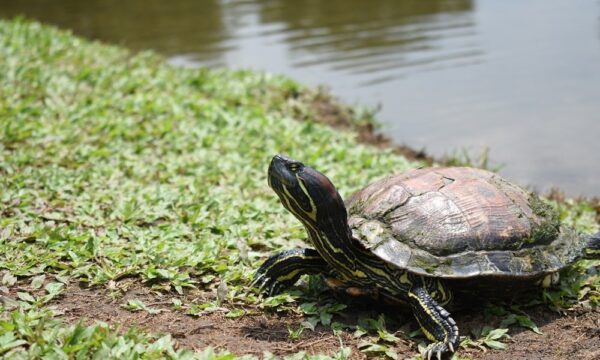
CABI’s experts in the field of invasive species management have highlighted the benefits of the CABI Horizon Scanning (HS) Tool and CABI Pest Risk Analysis (PRA) Tool to help fight a range of invasive species in the Caribbean.
Naitram Ramnanan, CABI’s Regional Representative, Caribbean, and Dr Norbert Maczey and Suzy Wood attended a workshop in Grenada aimed at improving biosecurity in Barbados and countries within the Organisation of Eastern Caribbean States (OECS).
The CABI staff demonstrated to representatives from Barbados, Bahamas, Antigua and Barbuda, Dominica, St Kitts and Nevis, St Lucia, St Vincent and the Grenadines, Trinidad and Tobago, how the CABI online tools can help build the capacity of regional biosecurity officers in the area of risk assessment of invasive species.
Such invasive species affecting the biosecurity and food security of the Caribbean islands include the tomato leafminer (Phthorimaea absoluta) as well as invasive weeds such as Tradescantia sp. and Callisia fragans – otherwise known as basketplant.
Islands in the Caribbean are particularly susceptible to the threat posed by IAS as islands are home to 15% of bird, reptile and plant species, and 67% of marine endemics (i.e. species unique to a particular geographic location) in the surrounding oceans. At present, 67% of globally threatened birds inhabiting oceanic islands are threatened with extinction compared to only 30% on continents.
CABI is already supporting plans for a Caribbean Invasive Species Trust Fund (CIAS TF) to help mitigate against the threats posed by other none-native plants and animals such as the aggressive vine Coral Creeper (Antigonon leptopus), Green Monkey (Chlorocebus sabaeus) and the Small Indian Mongoose (Urva auropunctatus).
The latest workshop, held as part of CABI’s work under the GEF project ‘Preventing COSTS of Invasive Alien Species (IAS) in Barbados and the OECS Countries’, sought to provide partners and stakeholders with training on the use of the HS and PRA tools – recently developed as integral part of the CABI Crop Protection and Invasive species compendia (CPC and ISC).
The event also builds on a series of other workshops, which aimed to train biosecurity teams in the region to develop PRAs. This includes a workshop held for UK Overseas Territories on Antigua in January 2020.
Mr Naitram Ramnanan said the workshop brought about some positive feedback from participants.
“A large majority concluded that the PRA tool is very useful and the workshop had been helpful in understanding how to use the tool in the future,” he said. “Feedback comments on the usefulness of the tools ranged from the tool saving time, asking the relevant questions, producing good reports, being easy to navigate to being absolute necessary.”
However, two participants also felt that the tool was difficult to navigate. Despite the largely positive feedback regarding both the usefulness of the tools and the training itself the majority still felt that further training in the use of the CABI tools was required.
It was also expressed that not only species prioritised through HS, which are not present in a specific PRA area as yet, need to be assessed but also many species, which are already present.
The participants also thought that in cases where the pathway is in itself an entity requiring a pest-initiated PRA (e.g. a plant or fruit), combining pest and pathway-initiated PRAs would reduce workload for cases where both must be considered and normally require both a pest and a pathway-initiated PRA. One example would be an exotic fruit for consumption where there is a risk that people will go on to plant seeds of the fruit.
Additional information
Main image: The tomato leafminer (Phthorimaea absoluta) is just one invasive species of concern in the Caribbean where the CABI PRA tools could benefit regional biosecurity officers (Credit: CABI).
CABI Horizon Scanning and Pest Risk Analysis tools
Find out more about the CABI Horizon Scanning Tool and the CABI Pest Risk Analysis Tool.
Preventing Invasives in the Caribbean
To find out more about Invasive Alien Species in the Caribbean visit the website www.caribbeaninvasives.org which outlines how scientists are collaborating to address the issue of IAS in the Caribbean.
Relevant project
You can find out more about the project ‘Preventing COSTS of Invasive Alien Species (IAS) in Barbados and the OECS Countries’ here.
Relevant news stories
See also the news stories ‘Biosecurity Interception System to be adopted across Caribbean to improve surveillance for Invasive Alien Species’ and ‘CABI supports plans for a Caribbean Invasive Alien Species Trust Fund to mitigate threats to biodiversity.’
1 Comment
Leave a Reply
Related News & Blogs
Biological control in action: Zambia’s field days on fighting fall armyworm
Experts from CABI recently held two field days and an expo in Zambia, showcasing innovative approaches to pest management to 584 farmers, agro-dealers and other stakeholders to help raise awareness of approaches to tackle the invasive fall armyworm (Sp…
11 June 2025





Great initiative by CABI! Pest Risk Analysis (PRA) support tools are essential for strengthening biosecurity and protecting Caribbean agriculture from invasive species. It’s encouraging to see proactive measures being highlighted to support sustainable farming and biodiversity in the region.